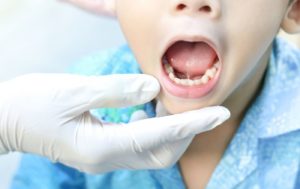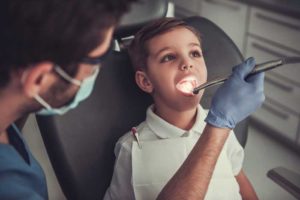Dental X-rays for children can be vital for detecting issues hidden beneath the surface of the teeth enamel and below the gum line. However, many parents have concerns about whether they are safe for their kids. The good news is that with modern technology, dental X-rays are safer than ever before.
First, in many dental offices, digital X-rays have largely replaced the old film versions. These digital X-rays are safer because they emit about 80 percent less radiation than film X-rays. In fact, the level of radiation from a set of digital X-rays is less than the level of radiation we naturally encounter in the course of one day.
The term “X-ray” refers to invisible electromagnetic radiation that can infiltrate human tissue. The amount of radiation (energy) absorbed depends on the density of the tissue, and this is how X-ray pictures (radiographs) are created. For instance, X-ray energy will pass through a cavity, producing a darker image, which will show on the film or sensor.
Vital for Detecting Issues
When deciding whether dental X-rays are necessary for a child, an experienced dentist will always weigh up the risks against the benefits, based on the youngster’s individual circumstances. Dental X-rays are never used indiscriminately, especially with children, because of their potential – albeit a minor risk – of causing cancer.
Furthermore, young people are more radiosensitive than adults, and the U.S. Food and Drug Administration (FDA), which regulates X-ray apparatus, recognizes that kids’ exposure to X-rays is a cause of parental concern. To address this, the FDA insists that X-ray units have special settings for children that minimize the effects of radiation.
Additionally, health professionals, including dentists, are advised to adhere to the ALARA principal on radiation dosage – As Low as Reasonably Achievable – and, in modern dentistry, digital X-ray technology and techniques allow for the delivery of extremely low levels of radiation.
Skilled dentists will never take X-rays as a matter of routine: they follow American Dental Association (ADA) and American Academy of Pediatric Dentistry (AAPD) guidelines on X-rays. The ADA and AAPD both recommend that X-rays should only be used after a clinical examination of the patient and a review of their medical history, including previous use and frequency of X-rays.
Benefits of dental X-rays for kids
While X-rays are diagnostic in nature, they also serve as a preventative measure, helping to spot issues in your child’s mouth before they become a major problem. Firstly, an examination of your kid’s teeth without an X-ray may not reveal many potential issues with the teeth and surrounding tissue, including small patches of decay beneath fillings, bone infection, abscesses, and tumors.
X-rays are also indispensable in detecting problems such as jaw and tooth-root issues, and gum disease including gingivitis. Furthermore, the discovery of these problems at an early stage is vital for an effective plan of treatment.
Without X-rays, on the other hand, issues not obviously apparent could go undiagnosed, resulting in progressive worsening, even to the extent of threatening your child’s overall health. In fact, left untreated, a gum infection can spread to other parts of the body, including the lungs, heart, and brain.
Different types of X-rays
Intraoral X-rays – the most common form of dental radiography – produce images from inside the mouth. They showcase precise details of teeth and supporting bones, enabling your youngster’s dentist to thoroughly evaluate tooth development and root health. Furthermore, the images allow the dentist to detect cavities and assess how securely the jaw bone is anchoring the teeth, as well as identify any potential needs for dental crowns.
Extraoral X-rays – which are taken outside the mouth, which focus on the larger bones in the head, particularly the lower and upper jaw. These images allow your child’s dentist to monitor the condition of the jaw joint and identify issues such as impacted teeth.
X-rays For Kids
A typical use of dental X-rays for kids is the creation of bitewing radiographs. Bitewings get their name from the small tabs or wings attached to the films or sensors that the child bites on. These X-rays are invaluable for spotting decay between the back teeth, where cavities are often not immediately apparent.
Panoramic radiography enable your child’s dentist to get an overall picture of the entire mouth in a single image. These X-rays not only show the condition of the teeth – including any yet-to-surface teeth – but they also reveal the state of the upper and lower jaws and the surrounding tissue and structures.
Orthodontic X-rays (cephalometric projections) show an entire side of your child’s head. Since the teeth are visible in the same image as the head and jaw, these images can be indispensable in planning orthodontic treatments to correct misaligned or crooked teeth.
Cone Beam Computerized Tomography (CBCT) X-rays provide a three-dimensional view of your child’s mouth when the dentist needs to gauge the spacing and development of the teeth.
Weigh up the pros and cons with your child’s dentist
Professional radiographers can interpret X-rays in detail to spot problems that would otherwise remain undetected. Moreover, X-rays play a crucial role in the diagnosis of teeth and gum issues, enabling appropriate action and treatment (such as the need for a tooth extraction) before the problem worsens.
Many diagnostic procedures can carry some risk. However, more often than not, the information provided by a dental X-ray will lead to long-term health benefits for your child that far outweigh the risks of the procedure.
If your dentist suggests your youngster should have an X-ray, ask them to explain how the results of the procedure will help your kid’s healthcare, and why another form of diagnosis would be less effective. To make an informed decision about whether your child should have dental X-rays, you need to be armed with information about the risks, benefits, and alternatives. Importantly, a good dentist will be happy to explain these aspects to you.
Furthermore, youngsters with a low risk of tooth decay don’t require X-rays as often. Therefore, encouraging your child to develop a good oral hygiene routine at home will help to minimize the need for X-rays.






